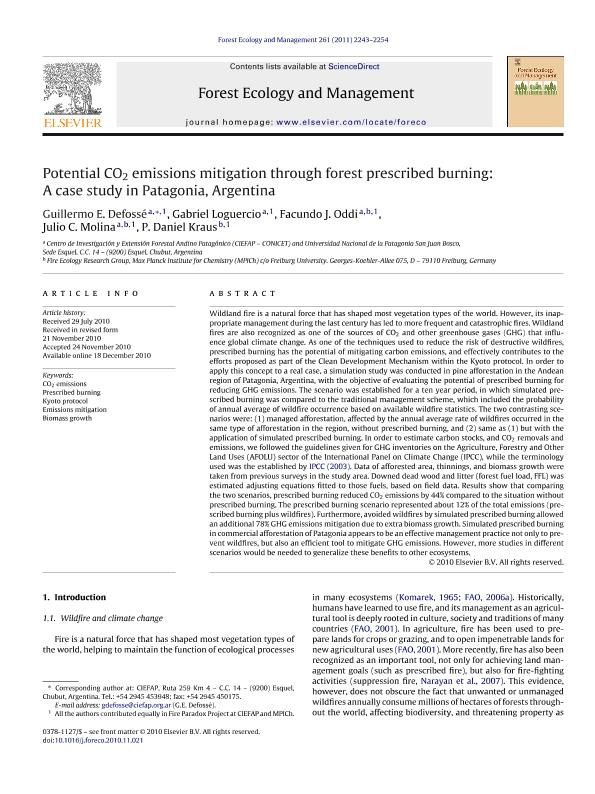Mostrar el registro sencillo del ítem
dc.contributor.author
Defossé, Guillermo Emilio

dc.contributor.author
Loguercio, Gabriel Angel

dc.contributor.author
Oddi, Facundo José

dc.contributor.author
Molina, Cristian Julio

dc.contributor.author
Kraus, Daniel
dc.date.available
2019-08-29T21:43:06Z
dc.date.issued
2011-06-15
dc.identifier.citation
Defossé, Guillermo Emilio; Loguercio, Gabriel Angel; Oddi, Facundo José; Molina, Cristian Julio; Kraus, Daniel; Potential CO2 emissions mitigation through forest prescribed burning: A case study in Patagonia, Argentina; Elsevier Science; Forest Ecology and Management; 261; 12; 15-6-2011; 2243-2254
dc.identifier.issn
0378-1127
dc.identifier.uri
http://hdl.handle.net/11336/82560
dc.description.abstract
Wildland fire is a natural force that has shaped most vegetation types of the world. However, its inappropriate management during the last century has led to more frequent and catastrophic fires. Wildland fires are also recognized as one of the sources of CO2 and other greenhouse gases (GHG) that influence global climate change. As one of the techniques used to reduce the risk of destructive wildfires, prescribed burning has the potential of mitigating carbon emissions, and effectively contributes to the efforts proposed as part of the Clean Development Mechanism within the Kyoto protocol. In order to apply this concept to a real case, a simulation study was conducted in pine afforestation in the Andean region of Patagonia, Argentina, with the objective of evaluating the potential of prescribed burning for reducing GHG emissions. The scenario was established for a ten year period, in which simulated prescribed burning was compared to the traditional management scheme, which included the probability of annual average of wildfire occurrence based on available wildfire statistics. The two contrasting scenarios were: (1) managed afforestation, affected by the annual average rate of wildfires occurred in the same type of afforestation in the region, without prescribed burning, and (2) same as (1) but with the application of simulated prescribed burning. In order to estimate carbon stocks, and CO2 removals and emissions, we followed the guidelines given for GHG inventories on the Agriculture, Forestry and Other Land Uses (AFOLU) sector of the International Panel on Climate Change (IPCC), while the terminology used was the established by IPCC (2003). Data of afforested area, thinnings, and biomass growth were taken from previous surveys in the study area. Downed dead wood and litter (forest fuel load, FFL) was estimated adjusting equations fitted to those fuels, based on field data. Results show that comparing the two scenarios, prescribed burning reduced CO2 emissions by 44% compared to the situation without prescribed burning. The prescribed burning scenario represented about 12% of the total emissions (prescribed burning plus wildfires). Furthermore, avoided wildfires by simulated prescribed burning allowed an additional 78% GHG emissions mitigation due to extra biomass growth. Simulated prescribed burning in commercial afforestation of Patagonia appears to be an effective management practice not only to prevent wildfires, but also an efficient tool to mitigate GHG emissions. However, more studies in different scenarios would be needed to generalize these benefits to other ecosystems.
dc.format
application/pdf
dc.language.iso
eng
dc.publisher
Elsevier Science

dc.rights
info:eu-repo/semantics/openAccess
dc.rights.uri
https://creativecommons.org/licenses/by-nc-sa/2.5/ar/
dc.subject
Biomass Growth
dc.subject
Co2 Emissions
dc.subject
Emissions Mitigation
dc.subject
Kyoto Protocol
dc.subject
Prescribed Burning
dc.subject.classification
Silvicultura

dc.subject.classification
Agricultura, Silvicultura y Pesca

dc.subject.classification
CIENCIAS AGRÍCOLAS

dc.title
Potential CO2 emissions mitigation through forest prescribed burning: A case study in Patagonia, Argentina
dc.type
info:eu-repo/semantics/article
dc.type
info:ar-repo/semantics/artículo
dc.type
info:eu-repo/semantics/publishedVersion
dc.date.updated
2019-08-23T18:39:40Z
dc.journal.volume
261
dc.journal.number
12
dc.journal.pagination
2243-2254
dc.journal.pais
Países Bajos

dc.journal.ciudad
Amsterdam
dc.description.fil
Fil: Defossé, Guillermo Emilio. Consejo Nacional de Investigaciones Científicas y Técnicas. Centro Científico Tecnológico Conicet - Patagonia Norte; Argentina. Centro de Investigación y Extensión Forestal Andino Patagónico; Argentina. Universidad Nacional de la Patagonia "San Juan Bosco"; Argentina
dc.description.fil
Fil: Loguercio, Gabriel Angel. Consejo Nacional de Investigaciones Científicas y Técnicas. Centro Científico Tecnológico Conicet - Patagonia Norte; Argentina. Centro de Investigación y Extensión Forestal Andino Patagónico; Argentina. Universidad Nacional de la Patagonia "San Juan Bosco"; Argentina
dc.description.fil
Fil: Oddi, Facundo José. Consejo Nacional de Investigaciones Científicas y Técnicas. Centro Científico Tecnológico Conicet - Patagonia Norte. Instituto de Investigaciones en Biodiversidad y Medioambiente. Universidad Nacional del Comahue. Centro Regional Universidad Bariloche. Instituto de Investigaciones en Biodiversidad y Medioambiente; Argentina. Centro de Investigación y Extensión Forestal Andino Patagónico; Argentina. Freiburg University; Alemania
dc.description.fil
Fil: Molina, Cristian Julio. Consejo Nacional de Investigaciones Científicas y Técnicas; Argentina. Centro de Investigación y Extensión Forestal Andino Patagónico; Argentina. Universidad Nacional de la Patagonia "San Juan Bosco"; Argentina. Freiburg University; Alemania
dc.description.fil
Fil: Kraus, Daniel. Freiburg University; Alemania
dc.journal.title
Forest Ecology and Management

dc.relation.alternativeid
info:eu-repo/semantics/altIdentifier/url/https://www.sciencedirect.com/science/article/pii/S0378112710006912
dc.relation.alternativeid
info:eu-repo/semantics/altIdentifier/doi/http://dx.doi.org/10.1016/j.foreco.2010.11.021
Archivos asociados
